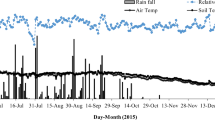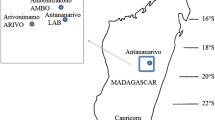Abstract
In experiments with transplanted rice (Oryza sativa L.) at the International Rice Research Institute, Philippines, two methods of split application of urea and ammonium sulfate were compared with deep, point placement (10 cm) of urea supergranules and broadcast application of a slow-release fertilizer sulfur-coated urea (SCU). Comparisons were made in the wet and dry seasons and were based on rice yield and N uptake. Urea- and ammonium-N concentrations and pH of the floodwater were measured to aid interpretation of the results.
Split applications of urea were generally less efficient than ammonium sulfate. The split in which the initial fertilizer dose was broadcast and incorporated into the soil before transplanting was more effective than the split in which the fertilizer was broadcast directly into the floodwater 21 days after transplanting. Both split applications were inferior to the urea supergranules and SCU, in terms of both yield and N uptake efficiency; average apparent N recoveries ranged from 30% for the delayed split urea to 80% for the urea supergranule.
Broadcast applications of urea and ammonium sulfate produced high floodwater concentrations of urea- and ammonium-N, which fell to zero within 4–5 days. Floodwater pH was as high as 9.3 and fluctuated diurnally due to heavy algal growth. Ammonia volatilization and algal immobilization of N in the floodwater were probably responsible for the poor efficiency of the split applications; the supergranules and SCU on the other hand produced low floodwater N concentrations and were efficiently used by the rice crop.
Similar content being viewed by others
References
Bouldin DR and Alimagno BV (1976) NH3 volatilization losses from IRRI paddies following broadcast applications of fertilizer nitrogen (Terminal report of DR Bouldin as visiting scientist at IRRI)
Craswell ET and De Datta SK (1980) Recent developments in research on nitrogen fertilizers for rice. IRRI Research Paper Series 49, p 11
Craswell ET and Vlek PLG (1979) Fate of fertilizer nitrogen applied to wetland rice. In International Rice Research Institute, Nitrogen and Rice, pp 175–192. Los Baños, Philippines
Craswell ET and Vlek PLG (1979) Greenhouse evaluation of nitrogen fertilizers for rice. Soil Sci Soc Am J 44, 1184–1188
De Datta SK (1978) Fertilizer management for efficient use in wetland rice soils. In Soils and Rice, pp 671–701. Los Baños, Philippines: International Rice Research Institute
De Datta SK and Craswell ET (1980) Nitrogen fertility and fertilizer management in wetland rice soils. A paper presented at the Special Symposium on Rice Research Strategies for the Future during the 20th Anniversary Celebration of the International Rice Research Institute, April 21–25, 1980. Los Baños, Philippines (in press)
De Datta SK, Garcia FV, Chatterjee AK, Abilay Jr WP, Alcantara JM, Cia BS and Jereza HC (1979) Biological constraints to farmers' rice yields in three Philippines provinces. IRRI Research Paper Series 30, 69
De Datta SK, Magnaye CP and Moomaw JC (1968) Efficiency of fertilizer nitrogen (15N-labelled) for flooded rice. Int Congr Soil Sci, Trans 9th (Adelaide, Aust) 4, 67–76
De Datta SK, Saladaga FA, Obcemea WN and Yoshida T (1974) Increasing efficiency of fertilizer nitrogen in flooded tropical rice. In The Fertiliser Association of India Proceedings of the FAI-FAO seminar on optimizing agricultural production under limited availability of fertilizers, pp 265–288. New Delhi, India
Engelstad OP, Getsinger JG and Stangel PJ (1972) Tailoring of fertilizers for rice. Bull Y-52, National Fertilizer Development Center, Tennessee Valley Authority, Muscle Shoals, AL 35660, USA
Freney JR, Denmead OT, Watanabe I and Craswell ET (1980) Ammonia and nitrous oxide losses following applications of ammonium sulfate to flooded rice. Aust J Agric Res 32, 37–45
Hauck RD and Bremner JM (1976) Use of tracers for soil and fertilizer nitrogen research. Adv Agron 28, 219–266
Huffman EO, Shirley Jr AR, Blouin GM and Dana GP (1975) Experience of Tennessee Valley Authority with sulfur-coated urea and other controlled release fertilizers. TVA Circular Z-59, Tennessee Valley Authority, Muscle Shoals, Alabama
International Atomic Energy Agency (1970) Rice fertilization. IAEA Technical Report Series 108, 1–177
International Rice Research Institute (IRRI) (1979) Preliminary report on the second international trial on nitrogen fertilizer efficiency in rice (1978) and summary report on the first and second international trials on nitrogen fertilizer efficiency in rice (1975–1978). International Network on Fertilizer Efficiency in Rice (INFER), Los Baños, Laguna, Philippines
Keeney DR and Bremner JM (1967) Determination and isotope ratio analysis of different forms of nitrogen in soils: No 7 urea. Soil Sci Soc Am J 31, 317–321
Mikkelsen DS, De Datta SK and Obcemea WN (1978) Ammonia volatilization losses from flooded rice soils. Soil Sci Soc Am J 42, 725–730
Mikkelsen DS and De Datta SK (1979) Ammonia volatilization from wetland rice soils. In Nitrogen and Rice, pp 135–156. Los Baños, Philippines: International Rice Research Institute
Mitsui S (1954) Inorganic nutrition, fertilization, and soil amelioration for lowland rice. Tokyo, Japan: Yokendo Ltd
Roger PA, Kulasooriya SA, Tirol A and Craswell ET (1980) Deep placement: a method of nitrogen fertilizer application compatible with algal nitrogen fixation in wetland rice soils. Plant and Soil (in press)
Savant NK, De Datta SK and Craswell ET (1980) Distribution patterns of NH +4 -N and15N uptake by rice after deep placement of supergranules of urea in wetland soil as influenced by placement depth and transplanting geometry. American Society of Agronomy Meetings, Detroit, Nov 30–Dec 5, 1980 (Abstract)
Stangel PJ (1979) Nitrogen requirement and adequacy of supply for rice production. In Nitrogen and Rice, pp 45–69. Los Baños, Philippines: International Rice Research Institute
Stangel PJ (1980) The world fertilizer sector — at a crossroads. Paper presented at the Symposium of Food Situation in Asia and the Pacific Region held April 24–29, 1980, at the Asian and Pacific Council, Food and Fertilizer Technology Center, Taipei, Taiwan, Republic of China
Tanaka A, Patnaik S and Abichandani CT (1959) Studies on the nutrition of rice plant (Oryza sativa L.) III. partial efficiency of nitrogen absorbed by rice plant at different stages of growth in relation to yield of rice (O. sativa var.indica). Proc Ind Ac Sci 49, 207–216
Vlek PLG and Craswell ET (1979) Effect of nitrogen source and management on ammonia volatilization losses from flooded rice soil systems. Soil Sci Soc Am J 43, 352–358
Vlek PLG and Stumpe JM (1978) Effect of solution chemistry and environment conditions on ammonia volatilization losses from aqueous systems. Soil Sci Soc Am J 42, 416–421
Vlek PLG, Stumpe JM and Byrnes BH (1980) Urease activity and inhibition in flooded soil systems. Fert Res 1, 191–202
Watt GW and Chrisp JD (1954) Spectrophotometric method for determination of urea. Anal Chem 26, 452–453
Wetselaar R, Shaw R, Firth P, Oupathum J and Thitipoca H (1977) Ammonia volatilization losses from variously placed ammonium sulphate under lowland rice field conditions in Central Thailand, pp 282–288. Tokyo, Japan: Proc Int Seminar on Soil Environment and Fertility Management in Intensive Agric
Author information
Authors and Affiliations
Rights and permissions
About this article
Cite this article
Craswell, E., De Datta, S., Obcemea, W. et al. Time and mode of nitrogen fertilizer application to tropical wetland rice. Fertilizer Research 2, 247–259 (1981). https://doi.org/10.1007/BF01050197
Issue Date:
DOI: https://doi.org/10.1007/BF01050197




